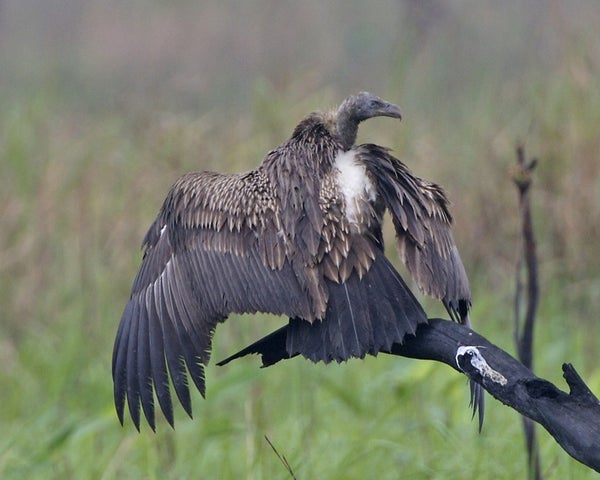This article was published in Scientific American’s former blog network and reflects the views of the author, not necessarily those of Scientific American
India has taken one more step to save its three critically endangered vulture species from extinction. Last week the country finally banned large doses of diclofenac, a painkiller that is often given to cattle and buffalo but which kills any vultures that eat the carcasses of treated animals. About 49 million vultures have died over the past 20 years, victims of renal failure caused by the drug. The loss of these admittedly unattractive carrion eaters has had cascading effects on India’s ecosystem. Without the birds to eat dead animals diseases have increased, feral dog populations have grown and even one religion that depended on vultures to consume their fallen believers has suffered.
India banned veterinary use of diclofenac back in 2006 but that law wasn’t enough to stop 70 less-than-legal companies from producing and selling the drug to livestock owners and veterinarians. Large vials of the human formulation of the anti-inflammatory painkiller remained readily available and widely used by farmers around the country. The new law bans any vial larger than three milliliters, which is enough to treat a person but too small to treat an animal. (Diclofenac is available in the U.S.; it has not been shown to have the same effect on New World vultures.)
Chris Bowden, program manager for Save Asia’s Vultures from Extinction (SAVE), says that his is “quite optimistic” about the new law and feels that it has the “teeth” necessary to finally stop the illegal diclofenac trade. He expects it might take about a year for the current supply of large vials to dry up and for the new law to make a difference.
On supporting science journalism
If you're enjoying this article, consider supporting our award-winning journalism by subscribing. By purchasing a subscription you are helping to ensure the future of impactful stories about the discoveries and ideas shaping our world today.
India’s action comes just a few days before International Vulture Awareness Day, which happens this Saturday, September 5. More than 80 zoos and organizations around the world will use the occasion to promote vulture conservation and spread the word about the threats these species face and vultures’ roles in the ecosystem.
Diclofenac was invented back in the 1960s but India’s introduction of the drug in the 1990s proved disastrous to the country's vultures. One species, the Indian white-rumped vulture (Gyps bengalensis), declined by a shocking 99.9 percent. The two other Indian species—the Indian vulture (G. indicus) and slender-billed vulture (G. tenuirostris)—each experienced similar declines. Other species in Nepal, Pakistan and other parts of Asia also suffered, as did vulture species in Africa, but the Indian species were hit hardest. All three Indian species were classified as critically endangered in 2000 but have, luckily, enjoyed modest population increases since the 2006 ban. They continue to die from eating the carcasses illegally treated animals, however. They also die from eating animals treated with a second drug, ketoprofen, that was brought in to replace diclofenac but which turned out to have similar vulture-killing side effects.
It’s somewhat easy to see why it took so long to get rid of diclofenac. For one thing, people know that it works. “Once you allow these drugs into the market, people are very resistant to change,” says Martin Gilbert, a field veterinarian with the Wildlife Conservation Society who was one of the researchers who first identified the fact that diclofenac was killing vultures.
In addition, Bowden says the drug acts faster than the best alternative, meloxicam, which has been proved save for vultures. “Diclofenac also has anti-pyretic properties, which means it also reduces fever,” he says. “Meloxicam needs other drugs in combination to do both.”
SAVE—a consortium of vulture-saving partner organizations—has done great work promoting the use of meloxicam, especially within several vulture safe zones in India and Nepal, where vitally important captive breeding is conducted. “In some areas subsidized or free meloxicam is given out to familiarize vets,” Bowden says. There are also more than 60 companies making the drug, “so the suspicion that we are promoting the drugs of certain companies is largely—if not entirely—allayed.”
Meanwhile other drugs are already coming onto the market and not all of them are good news for vultures. “We already know of two or three that are unsafe and gaining in popularity,” Bowden reports. “We’re risking a repeat of the problem.” He says they’re hoping that long-planned safety tests of other drugs—proposed two years ago by the Indian Veterinary Research Institute—may finally start soon “so that only vulture-safe drugs are approved for veterinary use.” Unfortunately funding for those tests has yet to emerge.
Now that India has taken action, hopefully other nations will follow. Vultures migrate between Asia and the European Union. Diclofenac remains for sale on Spain and Italy, which also happen to be the two European countries with the most vultures (including species that don’t live in India, which are also affected by the drug). Last year the European Medicines Agency advised that the E.U. ban diclofenac, but to date nothing has happened. “We’re very disappointed at the lack of progress on this,” Bowden says. “It now seems that we need to find and prove the death of vultures in the wild in Europe before any further action will be taken. India is setting a far better example on this.”
India’s vultures have slowly made the first steps toward recovery, but Gilbert says nothing will compare to the days in the late 1990s when he used to see huge flocks circling overhead. “We’ll never really get back to that point again,” he says. “Still, 15 years ago it looked very much like we wouldn’t have them at all. We should be thankful for that.”
Photo: A white-rumped vulture photographed in Assam, India by Lip Kee Yap. Used under Creative Commons license
